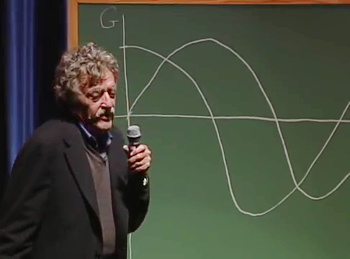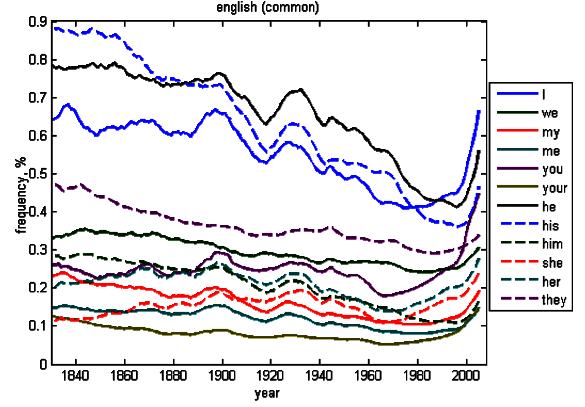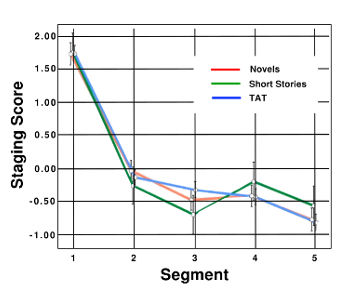Short Words
October 19, 2020
The
American author,
Kurt Vonnegut (1922-2007), is known as a writer of
science fiction, but his
novels are widely read, since their
scientific content serves as a vehicle for his unique perspective on life. I wrote about his
ice-nine in an
earlier article (Fictional Materials, April 21, 2016).
Ice-nine, not to be confused with the actual
ice-IX phase of
water, is a
fictional material in Vonnegut's novel,
Cat's Cradle. Vonnegut's phase of
water ice has the
dangerous physical that it will spontaneously
crystallize ordinary water into ice-nine under
normal temperatures and pressures. Unfortunately, this phase of water is stable, and it will only
melt at 45.8 degrees
Celsius. This well above
Earth ambient temperature even under the worst
global warming scenario.
Ice-nine eventually leads to the
solidification of all the world's water, and destruction of
life on Earth. Vonnegut said that he got this
idea from 1932
Nobel Chemistry Laureate,
Irving Langmuir. Langmuir had apparently suggested this as a
story line to
H. G. Wells, and Vonnegut heard about it while he was working in the
public relations department at
General Electric. Vonnegut considered the Ice-Nine idea to be free for him to use after both Langmuir and Wells had
died.

Kurt Vonnegut explaining his concept of "story arcs" at Case Western Reserve University in 2004.
(Screenshot from a YouTube video by Case Western Reserve University, November 29, 2016.)[1]
As contrasted with many authors who inflate their prose with too many
words, Vonnegut's books contain less
literary allusion. His books are short, and they can been read in a single sitting of a few hours. Since Vonnegut was
technically educated, he devised a
theory of
literary plot development,
graphically illustrated as
story arcs. You can learn about these in a
YouTube video of a February 4, 2004,
lecture he gave at
Case Western Reserve University (Cleveland, Ohio) (The story arc portion starts at 37:35 in this 54:56 lecture).[1] As Vonnegut said in this lecture, "... I have tried to bring scientific thinking to https://en.wikipedia.org/wiki/Literary_criticism, and there's been very little
gratitude for this."
Vonnegut's story arc
analysis requires considerable interpretation of
story text, and it won't be done by
computers until
artificial intelligence is somewhat more developed. However, computer analysis of literature using words and an elementary
knowledge of
grammar has been with us for quite some time. It's done such things as determining that multiple authors had a hand in writing books of the
Bible, and piecing together fragments of text into a readable version of the
Dead Sea Scrolls.[2]
A literary analysis feature has been present on
personal computer word processors since the earliest days of personal computing. I've written about these
Flesch-Kincaid readability tests[3] in two earlier articles (
Readability and Word Length, September 14, 2012, and
Readability, February 12, 2014). I've written a short
C language program (source code
here) that calculates these scores using some simplified analysis.
The Flesch-Kincaid tests are based on the simple idea that longer words and
sentences are more difficult than short words and short sentences. This simplification ignores the fact that there are many short
archaic and technical words unknown to
students. The
research for these tests was funded by the
US military, which wanted to ensure that their
training materials and
maintenance manuals were understood by its
recruits.
The two measures of readability are the Flesch-Kincaid grade level and the Flesch reading ease index, calculated as follows:
Flesch-Kincaid Grade =
(0.39*(words/sentences))+(11.8*(syllables/words))-15.59
Flesch Reading Ease =
205.835 - (1.015*(words/sentences))-(84.6*(syllables/words))
Words,
sentences and
syllables in these
formulas are the total counts of these objects in the
manuscript. The scale for reading is aligned with age group; viz., 90->100 = 11 year old, 60->70 = 13-15 year old, and 0->30 =
college graduates. The grade level is for
school grade levels in the United States. The articles in this blog are at about a tenth grade level, and my three science fiction novels have a very accessible sixth grade rating.

"Headless Body in Topless Bar" was the actual headline on the front page of the April 15, 1983, edition of The New York Post.[4]
Some publishers of supermarket tabloids use readability scores to ensure that their content is at the reading level of purchasers at the checkout.
(Created using Inkscape.)
A 2012 study by
scientists at the
Kazan Federal University (Kazan, Russia) examined the
Google Books corpus to determine trends in word usage.[5] They found that the
average word length of
American English declined from 4.8 to 4.3
characters in the period from 1975-2008, while that of
British English increased from 4.9-5.1 over the same period.[5] They also found the interesting
temporal trend in the use of
personal pronouns from 1700 to 2008 (see graph).[5]

Personal pronoun usage from 1835-2008. (Fig. 6 from ref. 5, via arXiv.)
A moment's
reflection will reveal that just about every narrative, from trivial
television dramas and
romance novels to
Oedipus Rex, has a progression from a beginning through a middle to an end. While any narrative has its specific
characters and
setting, it seems that all narratives have a structure that's independent of such details. Computer analysis has enabled a way to
quantify this structure, and a
tally of positive
vs negative "
emotion" words has given a means of sorting
rags-to-riches stories from
tragedies.

Literary analysis was done as early as 335 BC. This is a portion of Part VI of the c. 335 Poetics of Aristotle (384-322 BC). This translates as "The plot then is the first principle and as it were the soul of tragedy: character comes second." (Via the Tufts University Department of the Classics Perseus Digital Library
A simpler method of computer analysis has just been
published by
psychologists from
Lancaster University (Lancaster, UK) and the
University of Texas at Austin (Austin, Texas). Their study is published as an
open access paper in
Science Advances.[6-9] They did a computer analysis on about 40,000 narratives that included such things as novels,
screenplays, 28,664
New York Times articles, 1,580
US Supreme Court opinions, and 2,226
TED talks.[6-7] The analysis revealed a common
structure in most of three primary
processes; namely, staging, plot progression, and
cognitive tension, which was absent in
factual texts.[6]
Since the narrative structure was independent of topic, the researchers reasoned that it should be apparent in content-free words,
function words, short connector words such as
pronouns (she, they),
preposition,
articles (a, the),
conjunctions, and
negations Such function words also include
auxiliary verbs, and non
referential adverbs, such as "so" and "really."[6-7] There is just a small number of common function words in
English, fewer than 200, but they account for 50 to 60% of all words that are written, or said.[6] These small function words appear in a similar pattern across most narratives, independent of length or type.[7]
The common structure of the narratives followed these three stages:[7]
Staging, the start of the narrative in which many prepositions and articles were used, apparently as a means set the scene and convey basic information about concepts and characters in the story (e.g., "the laboratory,").
Plot progression in which more interactional language is used, including auxiliary verbs, adverbs and pronouns (e.g., "his laboratory.").
Cognitive tension using action words, such as "think" and "cause," that brings the narrative to a conclusion.
Says lead author of the study,
Ryan Boyd, an
assistant professor at Lancaster University,[7]
"If we want to connect with an audience, we have to appreciate what information they need, but don’t yet have... At the most fundamental level, humans need a flood of logic language at the beginning of a story to make sense of it, followed by a rising stream of action information to convey the actual plot of the story."

Use of articles and prepositions over the course of a narrative.
TAT is a collection of 14,419 brief stories written in response to a standardized thematic apperception test by individuals who accessed a website maintained by an author of the study.
(Created using data from a YouTube Video.[8])
References:
- Kurt Vonnegut February 4, 2004, Lecture at Case Western Reserve University, YouTube Video, November 29, 2016. A shorter version with Spanish subtitles can be found here.
- Ron Grossman, "Computer Generates Bootleg Copy Of Dead Sea Scrolls." Chicago Tribune, September 4, 1991.
- J. Peter Kincaid, Richard Braby and John E. Mears, "Electronic authoring and delivery of technical information," Journal of Instructional Development, vol. 11, no. 2 (June, 1988), pp. 8-13.
- Steve Cuozzo, "The genius behind 'Headless Body in Topless Bar' headline dies at 74," New York Post, June 9, 2015.
- Vladimir V. Bochkarev, Anna V. Shevlyakova and Valery D. Solovyev, "Average word length dynamics as indicator of cultural changes in society," Social Evolution & History. vol. 14, no. 2 (September, 2015), pp. 153-175. Also at arXiv.
- Ryan L. Boyd, Kate G. Blackburn and James W. Pennebaker, "The narrative arc: Revealing core narrative structures through text analysis," Science Advances, vol. 6, no. 32 (August 7 2020), Article no. eaba2196, DOI: 10.1126/sciadv.aba2196. This is an open access article with a PDF file available here.
- Authors' 'Invisible' Words Reveal Blueprint for Storytelling, University of Texas Press Release, August 7, 2020.
- Science Advances: The Arc of Narrative, YouTube Video by Ryan Boyd, August 7, 2020.
- The Arc of Narrative website.
- Aristotle, "Poetics," S. H. Butcher, Trans., at the The Internet Classics Archive by Daniel C. Stevenson.
Linked Keywords: America; American; author; Kurt Vonnegut (1922-2007); science fiction; novel; science; scientific; ice-nine; ice-IX; phase (matter); water; fiction; fictional; material; Cat's Cradle; water ice; hazard; danger; physical property; crystallization; crystallize; normal temperatures and pressures; melting; melt; Celsius; Earth; ambient temperature; global warming; worst-case scenario; freezing; solidification; life on Earth; idea; Nobel Prize in Chemistry; Nobel Chemistry Laureate; Irving Langmuir; plot (narrative); story line; H. G. Wells; public relations; General Electric; death; died; concept; Case Western Reserve University; YouTube video; word; literary allusion; technology; technical; theory; literary plot development; graphics; graphical; illustration; illustrated; lecture; gratitude; analysis; story text; computer; artificial intelligence; knowledge; grammar; Bible; Dead Sea Scrolls; personal computer; word processor; Flesch-Kincaid readability tests; C language program; readability.c; sentence (linguistics); archaism; archaic; student; research; United States Armed Forces; US military; training; maintenance; user guide; manual; army recruit; sentence (linguistics); syllable; formula; manuscript; college graduate; school grade levels in the United States; headline; The New York Post; publishing; publisher; supermarket; tabloid; readability; dumbing down; reading level; point of sale; checkout; Inkscape; scientist; Kazan Federal University (Kazan, Russia); Google Books; corpus; mean; average; American English; alphabet character; British English; time evolution; temporal trend; personal pronoun; arXiv; reflection (thought); television drama; romance novel; Oedipus Rex; character (arts); scenario; setting; quantification; quantify; tally; emotion; rags-to-riches; tragedy; literary criticism; literary analysis; Anno Domini; BC; Poetics (Aristotle); Aristotle (384-322 BC); translation; principle; soul; Tufts University Department of the Classics Perseus Digital Library; scientific literature; psychologist; Lancaster University (Lancaster, UK); University of Texas at Austin (Austin, Texas); open access paper; Science Advances; screenplay; The New York Times; Supreme Court of the United States; opinion; TED (conference); TED talks; structure; process; cognition; cognitive; psychological stress; tension; nonfiction; factual text; pronoun; preposition; aArticle (grammar); conjunction (grammar); negation; auxiliary verb; indexicality; referential; adverbs; English language; Ryan Boyd; assistant professor; audience; flood; stream; theme (arts); thematic; apperception; evaluation; test; website; author; study; Kurt Vonnegut February 4, 2004, Lecture at Case Western Reserve University, November 29, 2016.